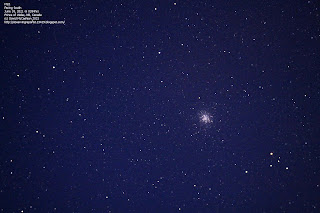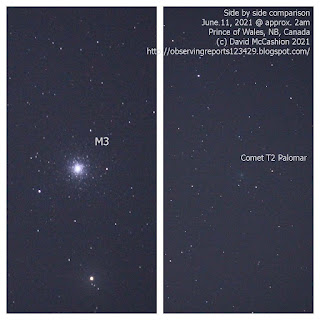Location: Prince of Wales, NB, Canada
Date Time: December 27, 2021 1800-1930
Weather: No wind except for a slight breeze for a few minutes, mostly clear, -2C, 73% humidity. Excellent viewing conditions!
Equipment: Canon Rebel T3 attached to an 80 ed/apo at prime focus and with an 18-55mm lens. Images processed with PhotoShop.
Attendance: David McCashion.
Objective: To image comets 19P Borrelly(mag10) and 104P Kowal(mag 11), which were in the southern sky in the early evening.
Report:
- The comets were close together in the southern sky. Images seemed to show 19P to be smaller
of the two, but with a much brighter central region. This comet may brighten as it approaches Earth. Comet 104P appeared larger of the two, with a more diffuse central region, and with possibly a curved tail. It will get very
close to Earth, according to its reported path. Their paths are
noteworthy, in my opinion, seemingly coming up from behind the Earth and
passing it in its orbit. Comet images were all cropped approximately the same and had the same settings to make comparison more possible.
 |
| Comet 19P Borrelly, single shot, 61 sec, ISO 1600, cropped and processed. |
 |
| Comet 19P Borrelly, single shot, 61 sec, ISO 6400, cropped and processed. |
 |
| Comet 19P Borrelly, Inverted image. |
 |
| Comet 104P Kowal, 61 second, ISO 6400, cropped and processed. |
 |
| Same image as above inverted. |
- The comets were to the left of Jupiter, which was in the south western sky. Took a wide angle image of the whole southern sky and a close-up of Jupiter.
 |
| Facing south, 25 sec, f/3.5, ISO 3200, focal length 18mm. |
 |
| Jupiter through telescope, 1/8 second, ISO 1600. |
- In the middle of the Summer Triangle, which was lowering in the western sky during observing, there's an amazing double star named Albireo. An excellent small telescope target. Note the color difference between the two stars.
 |
| Facing west, summer triangle, 25 sec, f/3.5, ISO 3200, focal length 18mm |
 |
| Albireo through telescope, 5 second, ISO 800. |
- The viewing conditions were so good for the entire sky, in every direction, I decided to image the northern and south eastern sky as well, to show which constellations were showing.
 |
| Facing north, Big Dipper behind the treeline,25 sec, f/3.5, ISO 3200, focal length 18mm |
 |
| Facing south east, Orion, 15 sec, f/3.5, ISO 3200, focal length 18mm. |
- Many satellites were seen, with a few going through images. One long exposure image of the comets had two satellites in it. No shooting stars were seen.








































